Effect of sintering temperature on luminescence properties of borosilicate matrix blue–green emitting color conversion glass ceramics?
Qiao-Yu Zheng(鄭巧瑜),Yang Li(李楊),Wen-Juan Wu(吳文娟),?,Ming-Ming Shi(石明明),Bo-Bo Yang(楊波波),3,and Jun Zou(鄒軍),4
1School of Science,Shanghai Institute of Technology,Shanghai 201418,China
2School of Material Science and Engineering,Shanghai Institute of Technology,Shanghai 201418,China
3Institute of Beyond Lighting,Academy for Engineering and Technology,Fudan University,Shanghai 200433,China
4Institute of New Materials&Industrial Technology,Wenzhou University,Wenzhou 325024,China
Keywords:(SrBaSm)Si2O2N2:(Eu3+Ce3+)phosphors,blue–green color conversion glass ceramic,luminescent intensity,thermal quenching effects,sintering temperature
1.Introduction
Under the condition that energy is getting scarce,white light-emitting diodes(WLEDs)have attracted extreme attention in various fields because of their high efficiency,energy saving,shock resistance,long lifetime,environmental friendliness,and fast response.[1–7]However,with the development of technology,WLEDs with only high-power performance can no longer meet the market demand.Full-spectrum WLEDs have been exploited for their similar luminescence properties to the sunlight,which have higher color rendering index,higher light efficiency,and stronger color reproduction capability,can also solve the problem of excessive blue light damage.[8–12]Compared with general WLEDs,the full-spectrum WLED is usually synthesized by adding phosphors of 490 nm and 660 nm to complement short-wave blue–green light and long-wave red light,so that the spectral wavelength covers the entire visible light.[13–15]At present,phosphors with a wavelength of 660 nm have been extensively studied.[16–20]Therefore,the blue–green phosphor in the 490-nm band is a key issue in the research and preparation of full-spectrum LEDs.Currently,some blue–green phosphors,for example silicate(M2SiO4:Eu2+,M=Ca,Ba,Sr),sulfide(M2BS4: Eu2+,M=Ba,Sr,Ca,B=Al,Ga,In)aluminate(MSrAl37:Eu2+,M=Y,La,Gd),have been developed. However,the traditional silicate system has the narrow emission peak and the poor color rendering,the conventional sulfide phosphors usually have poor stability,sensitivity to environmental moisture and atmosphere,the aluminate is difficult to prepare,the cost is high and hydrolysis is easy to occur.[21–23]Oxynitride-based phosphors system[24,25]like(SrBaSm)Si2O2N2:(Eu3+Ce3+)blue–green phosphor materials have great value in research,because it possesses many advantages such as high luminous efficiency,effective excitation by visible light,high designability of fluorescence characteristics(wide adjustment range),high thermal stability,and environmental friendliness. Otherwise,the process technology of package full spectrum WLEDs also needs to overcome the easy aging and yellowing of silicone.[26–28]At home and abroad,lots of works of color conversion glass ceramics for white LEDs had been done.[29–32]At present,the glass material used in the color conversion glass ceramic research mainly include:bismuthate glass matrix material,[33]tellurate glass matrix material,[34]and borosilicate glass matrix material.[35]Compared to the other two glass matrix material,the borosilicate glass matrix material has two main advantages:(i)The borosilicate glass matrix material has a good thermal stability and prevents the phosphor from failing under high temperature and high humidity,(ii)The borosilicate glass matrix material is relatively stable,which can realize the glass ceramics with multi-wavelength phosphor doping.Therefore,it is necessary to study properties of borosilicate matrix blue–green color conversion glass ceramics.[36,37]
In this study,at the sintering temperature of 600?C–800?C,the borosilicate glass matrix and blue–green phosphors were co-sintered into color conversion glass ceramics,and the holding time was 20 minutes. The effect of sintering temperature on the luminescence properties of borosilicate matrix blue–green color conversion glass ceramics was studied. We can judge the luminescent properties of blue–green color conversion glass ceramics by the change of photoluminescence(PL)intensity at each sintering temperature.Moreover,the lattice structure of phosphors and glass ceramics at various sintering temperatures can be investigated by x-ray diffraction(XRD)and the content and variation of Ce3+and Eu3+can be measured by x-ray photoelectron spectrum analyzer to investigate the properties of color conversion glass ceramics at high sintering temperature.
2.Experiment
In this process,the blue–green color conversion glass ceramics can be obtained by a two-step method in lowtemperature co-sintering. Firstly,the weighed and mixed medicine which was made up of H3BO3,SiO2,ZnO,BaCO3,Na2CO3for firing the glass matrix was sintered in a muffle furnace at 1100?C for 1 h. Secondly,the transparent high-temperature liquid taken out from the muffle furnace was cooled on a copper plate at room temperature. Thirdly,the ground glass matrix powders with a d50of 15μm was doped with 3 wt%(SrBaSm)Si2O2N2: (Eu3+Ce3+)blue–green phosphors powders with a d50of 15μm,and placed in a muffle furnace at 600?C–800?C for 20 min.Last but not least,the prepared blue–green color conversion glass ceramics were polished to a thickness of 1 mm by a sander.In order to better study the luminescence properties of color conversion glass ceramics with sintering temperature,we also studied the variation of luminescence properties of phosphors sintered at 600?C–800?C for 20 min as a comparison.
The lattice structure of the prepared sample can be characterized by x-ray diffraction(XRD,Rigaku, Ultima IV,Japan)over a 2θ range between 10?and 80?with Cu Kα radiation(k=0.154178 nm)at a scanning rate of 0.02?/step and 4?/min. The photo-luminescence(PL)and PL excitation(PLE)and QY of all samples which contained blue–green phosphors and color conversion glass ceramics were recorded by Hitachi F-7000 spectrofluorometer and the integrating sphere with a xenon lamp as the light source. The luminescence properties of the color conversion glass ceramics can be suggested by calculating the ratio of the area occupied by divalent europium ions and trivalent europium ions by x-ray photoelectron spectrum analyzer(XPS,Escalab250Xi,ThermoFisher)data.All the binding energies were calibrated by using the carbon 1s line(C 1s=284.91 eV)as a reference.
3.Results and discussion
We can observe the PLE and PL spectra of the(SrBaSm)Si2O2N2: (Eu3+Ce3+)blue–green phosphors and color conversion glass ceramics sintered at 600?C–800?C for 20 min from Fig.1.Figures 1(a)and 1(c)show the PLE spectra of the phosphors and color conversion glass ceramics respectively monitored at maximum emission wavelength of 490 nm.Figures 1(b)and 1(d)display the emission spectra of the phosphors and the color conversion glass ceramics sintered at various temperatures.It is worth noting that the blue–green phosphors have a wide excitation band that can extend from 380 nm to 470 nm,this means that it can match well with the current mainstream blue LED chips. What is more,the center wavelength of PLE and PL spectra of the color conversion glass ceramics is consistent with the center wavelength of the phosphors due to the same transition of Ce3+and Eu3+,which is related to the dipole transition of the 5d excited state to 4f ground state of Ce3+,[38,39]and the f–f forbidden transition of Eu3+[40,41]in the blue–green phosphors lattice respectively.As the sintering temperature increased,both the excitation peak intensity and the emission peak intensity of the phosphors and the color conversion glass ceramics changes significantly. When the sintering temperature is higher than 750?C,the excitation and emission spectra of the phosphors and the color conversion glass ceramics have almost no peak in Fig.1.
Figure 2 is a dotted line diagram of the internal quantum efficiency of color conversion glass ceramics and blue–green phosphors at different sintering temperatures.It can be clearly seen that the internal quantum efficiency of the glass ceramics and phosphors reaches a high internal QY value of 44.80%and 93.49%respectively at 600?C,then decreases linearly with increasing sintering temperature,even closes to zero when the temperature exceeds 750?C.This is consistent with the result that the PL intensity shown in Fig.1.
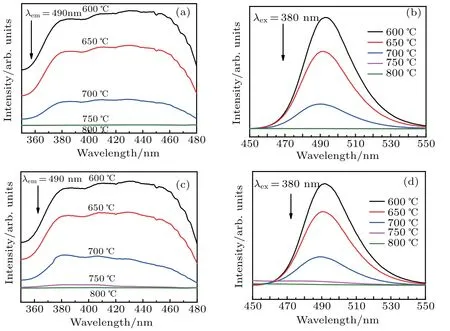
Fig.1.PLE and PL spectra of phosphors and color conversion glass ceramics between 600 ?C–800 ?C:(a)PLE of blue–green phosphors,(b)PL of blue–green phosphors,(c)PLE of blue–green color conversion glass ceramics,(d)PL of blue–green color conversion glass ceramics.
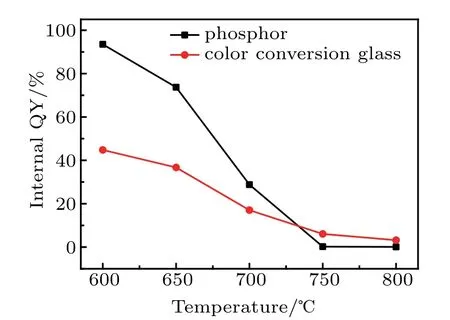
Fig.2. Internal QY diagram of the blue–green phosphors and glass ceramics at different sintering temperatures.
In order to further confirm the regular pattern of the change of the luminescent properties of glass ceramics with the increase of the sintering temperature,the CIE coordinates at different sintering temperatures of glass ceramics and phosphors are shown in Fig.3. Figure 3 reveals the variation of the CIE coordinates of phosphors and color conversion glass ceramics,which is consistent with the result of the PL intensity as shown in Fig.1. When the sintering temperature is lower than 700?C,the x axis of the CIE coordinates of the glass ceramics increases slowly with the increasing sintering temperature,and the y axis slowly decreases.When the sintering temperature exceeds 750?C,however,the CIE coordinate changes abruptly,and the region is almost beyond the region of the cyan–blue.

Fig.3.CIE coordinates diagram of blue–green phosphors and glass ceramics at various sintering temperatures:(a)CIE of phosphors,(b)CIE of glass ceramics.
In order to more intuitively describe the variation of x axis and y axis of the CIE coordinates of(SrBaSm)Si2O2N2:(Eu3+Ce3+)color conversion glass ceramics and phosphors with increasing sintering temperature,it can be seen that the variable values of x and y in CIE coordinates at different sintering temperatures between color conversion glass ceramics and phosphors are in the range of 600?C–800?C as shown in Fig.4.As the sintering temperature increases,the difference in y value between the color conversion glass ceramics and phosphor decrease obviously and the difference in x value has an upward trend.It is worth noting that the variable value of CIE-x,y between glass ceramics and phosphors is the closest when co-sintering temperature is 600?C.The above results once again fit the conclusion that the increase of sintering temperature has a negative effect on the luminescence properties of glass ceramics.
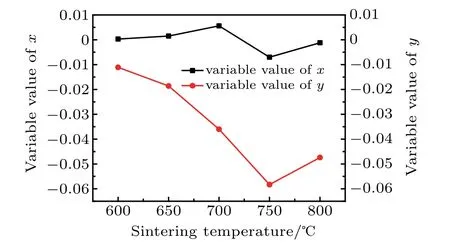
Fig.4. The variable values of x and y in CIE coordinates at different sintering temperatures between color conversion glass ceramics and phosphors in the range of 600 ?C–800 ?C.
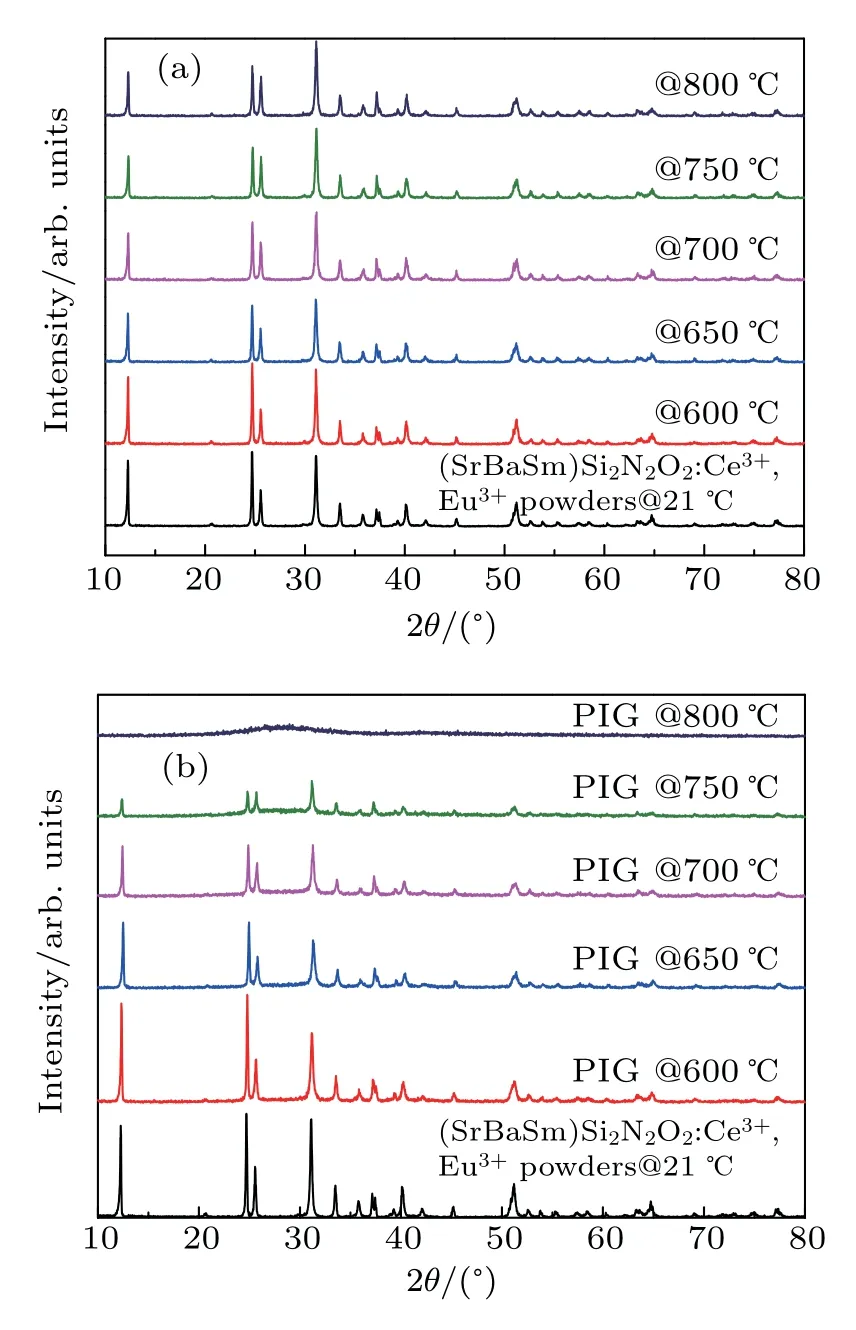
Fig.5.XRD patterns of phosphors and color conversion glass ceramics at different sintering temperatures:(a)XRD of phosphors,(b)XRD of glass ceramics.
As reported in literature,[42–46]Since Eu3+has one couple of adjacent thermally coupled energy levels TCL,5D1and5D0,which are populated by the nonradiative relaxation,the phosphors were thermally quenched significantly at high sintering temperature,resulting in failure of the phosphor.This is the main reason for the weakening of the PL and PLE intensities of the(SrBaSm)Si2O2N2:(Eu3+Ce3+)blue–green phosphors.
In order to further study the reasons for the failure of luminescence performances for color conversion glass ceramics at higher sintering temperature,XRD patterns of phosphors and color conversion glass ceramics at different sintering temperatures in Fig.5 and XPS spectra of glass ceramics at 600?C and 750?C in Figs.7 and 8 are tested experimentally. As shown in Fig.5,the lattice structure of(SrBaSm)Si2O2N2:(Eu3+Ce3+)blue–green phosphors has basically no change,while the lattice structure of glass ceramics varies significantly with the increase of sintering temperature.When the sintering temperature exceeds 750?C,the lattice structure of glass ceramics is seriously damaged which may result in a decrease in luminescence performance,because the lattice structure of the phosphors had been destroyed by the glass matrix at high sintering temperature.
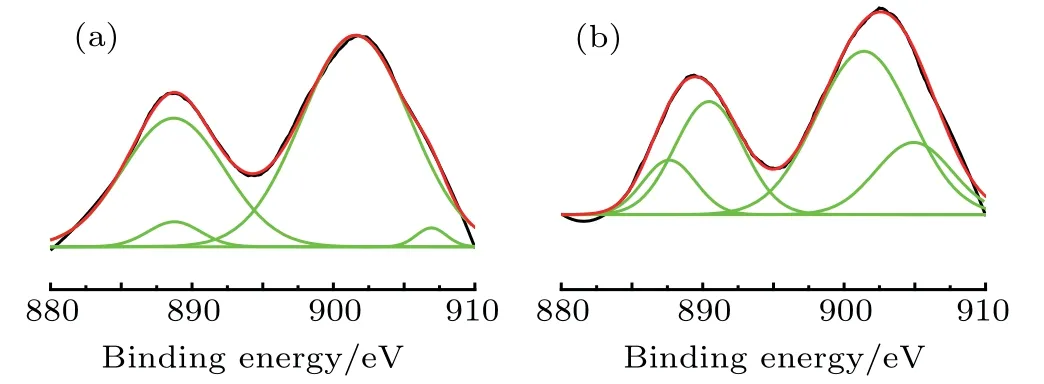
Fig.6.XPS spectrum and fitting curves of Ce3+in the color conversion glass ceramics sintered at 600 ?C(a)and 750 ?C(b).
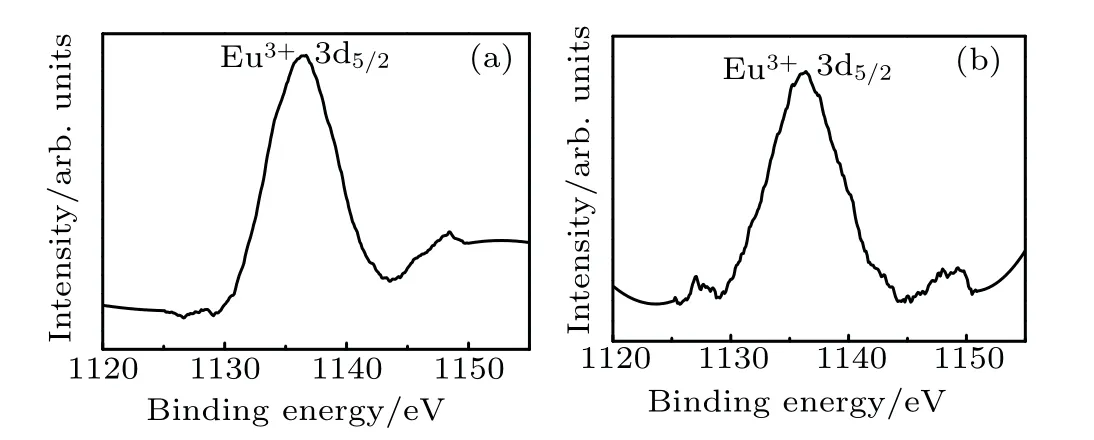
Fig.7.XPS spectrum of Eu3+of the color conversion glass ceramics sintered at 600 ?C(a)and 750 ?C(b).
The values of binding energies for Ce3+3d5/2,Ce3+3d3/2,Eu3+3d5/2, and Eu3+3d3/2are 884, 902, 1135.1, and 1664.3 eV respectively which are queried from the standard XPS map database,while the binding energies of Ce4+3d5/2and Ce4+3d5/2are 881.6 eV and 899.9 eV respectively.Figure 7 is the XPS spectrum of Eu3+at 600?C and 750?C,which indicates that the valence state of Eu3+has not changed under high sintering temperature conditions.Figure 6 shows the XPS spectrum of Ce3+at 600?C and 750?C.The peaks are fitted to all the samples,and the area of the fitted peaks and the relative content of the luminescent ions are calculated.The results are shown in Table 1.When the sintering temperature increases from 600?C to 750?C,the content of Ce3+of the color conversion glass ceramics reduces from 94.97%to 58.39%,and the content of Ce4+of the color conversion glass ceramics increases from 5.03%to 41.61%,which indicates that Ce3+is oxidized to Ce4+during the sintering process,so that the luminescent intensity of the glass ceramics in the 490 nm is lowered at a higher sintering temperature.

Table 1.Relative percentage of Ce3+in the glass ceramics sintered at 600 ?C and 750 ?C.
4.Summary
Through a series of tests,the luminescence properties of(SrBaSm)Si2O2N2:(Eu3+Ce3+)blue–green color conversion glass ceramics changed with sintering temperature is experimentally studied and verified. When the sintering temperature raises from 600?C to 700?C,the luminous intensity of the color conversion glass ceramics is gradually weakened,but still possess luminescent properties.However,when the sintering temperature exceeds 750?C,the luminescence intensity of the glass ceramics decreases linearly and approaches to zero.Meanwhile,the color conversion glass ceramics have almost no fluorescence characteristics.The blue–green phosphors were thermally quenched at 750?C.Moreover,the lattice structure of the phosphors was destroyed by the glass matrix and the Ce3+in the phosphors was oxidized to Ce4+,which further caused a decrease in luminescent intensity of color conversion glass ceramics. In general,the experimental results show that low sintering temperature has a positive effect on the luminescence properties of blue–green color conversion glass ceramics.
- Chinese Physics B的其它文章
- Theoretical analyses of stock correlations affected by subprime crisis and total assets:Network properties and corresponding physical mechanisms?
- Influence of matrigel on the shape and dynamics of cancer cells
- Benefit community promotes evolution of cooperation in prisoners’dilemma game?
- Theory and method of dual-energy x-ray grating phase-contrast imaging?
- Quantitative heterogeneity and subgroup classification based on motility of breast cancer cells?
- Designing of spin filter devices based on zigzag zinc oxide nanoribbon modified by edge defect?

